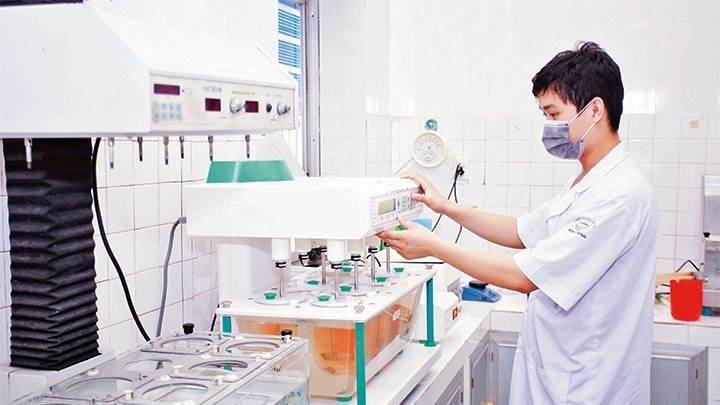Resources for innovative enterprises
Previously, many enterprises encountered difficulties in utilising the Science and Technology Development Fund for business due to institutional obstacles. The Law on Science, Technology and Innovation removes many barriers, expands autonomy, and helps enterprises to be more proactive in research, technology development, and product commercialisation.

Enterprises expanded rights to use the fund
According to the Law on Science, Technology and Innovation, the Science and Technology Development Fund of enterprises is formed from allocations stipulated by the law on corporate income tax as well as from lawful contributions or donations by organisations and individuals.
The fund is used to conduct scientific research, technology development, and innovation; support the application of basic standards, registration, and protection of intellectual property rights; organise or hire research abroad; purchase, merge, invest in, or co-invest in projects or innovative start-ups; as well as carry out other tasks as stipulated.
Enterprises have the right to autonomy and are responsible for managing and using the fund. For state-owned enterprises, the fund may also be used to implement key projects and strategic technologies under special mechanisms.
When investing in innovative start-ups, the use of the fund must ensure openness, transparency, financial risk control, and compliance with approved limits. If enterprises follow the correct processes and regulations with openness and transparency but still face risks or losses, they will be exempt from civil liability and related administrative responsibility.

It is shown that the mission of the Science and Technology Development Fund of enterprises is to create favourable conditions for enterprises to promote research, technology development, innovation, and enhance competitiveness, while also reflecting the state’s policy of mobilising social resources to invest in science, technology, and especially technological innovation of enterprises.
A representative of the Department of Planning and Finance, Ministry of Science and Technology, said that the Law on Science, Technology and Innovation has designed a synchronous system of funds at the national, local, and enterprise levels.
For funds in enterprise, the law does not apply capital preservation requirements for each specific task, creating more flexible conditions in implementation; they are entitled to sponsor or order research tasks, support interest rates, or contribute investment capital for innovation activities, and are not limited by the fiscal year.
This approach helps enterprises to be more proactive in allocating resources, taking advantages of market opportunities, and promoting the commercialisation of research results. In recent times, under the old regulations, enterprises were allowed to set aside pre-tax profits to establish the Science and Technology Development Fund, but the rate of funding used for research and technological innovation was still low.
Many enterprises have initiated funds from their early establishment, but they were still unclear about legal procedures, leading to restrictions in allocation and usage, and shortcomings in using procedures and disbursement efficiency.
Many enterprises feared the risk of retroactive tax collection or penalties if funds were spent incorrectly, so they either did not allocate funds or allocated them but left them unused.
For example, the Viet Nam Rubber Group once had to return as much as 84% of its allocated funding due to failure to implement any significant research and development activities. The FDI business sector has also paid no attention to this fund mechanism, as the financial benefits were not commensurate with the risks of using.
Expectations for innovation promotion
With expectations from this new policy, many enterprises believe that the new law has introduced mechanisms more suitable with enterprises’ actual situation. Notably, expanding the scope of fund expenditures, including hiring or contracting research and development, or supporting intellectual property and technical standards, is considered highly practical.
For small enterprises, initial investments in innovation, though not large, are very important. With suitable funding or co-funding mechanisms, enterprises will be more motivated to invest in technology, test new models, and create smart products, close to real needs.
From the perspective of a start-up, Dang Xuan Truong, Director of Hachi Viet Nam High-tech Joint Stock Company, highly appreciated that the Law on Science, Technology and Innovation provides mechanisms more suitable with the reality of small enterprises, especially allowing enterprise’s Science and Technology Development Fund to support research, technology transfer, and investment in start-ups, or co-investment with venture funds and research organisations domestically and abroad.
These are very specific needs that his company previously found difficult to access due to a lack of clear mechanisms. Many enterprises also suggest that, to promote effectiveness, relevant authorities should establish a centralised platform, such as an integrated electronic portal, to provide comprehensive information on funds, especially enterprise’s science and technology development funds, submission procedures, lists of supporting experts, reports on funded projects, and so on.
At the same time, organising direct consultation programmes will help enterprises not feel isolated when they wish to innovate but lack resources. In addition, the law should be quickly concretised with clear, accessible guidelines for enterprises, especially start-ups, regarding evaluation criteria, application procedures, and support levels.
Procedures should be designed in the spirit of “streamlined–transparent–with advisory support” instead of being too heavy on administrative procedures or requirements on organisational capacity like big enterprises.
According to the representative of Hachi Viet Nam High-tech Joint Stock Company, if “all-in-one support packages” could be designed following a funding model — for example, subsidising part of the cost of testing new technology, while investing in digital agricultural products or supporting small-scale research equipment purchases — start-ups like Hachi Viet Nam High-tech Joint Stock Company would have the conditions to take advantage and proactively build a methodical technology development roadmap from early.
Dr. Tran Van Khai, Deputy Chairman of the National Assembly’s Committee for Science, Technology and Environment, emphasised that the state has been implemented funds to support science and technology and innovation in order to accompany start-ups.
Therefore, enterprises and start-ups should boldly take advantages of the support resources to jointly create new products and services that not only bring economic benefits to themselves but also address the country’s development challenges.








